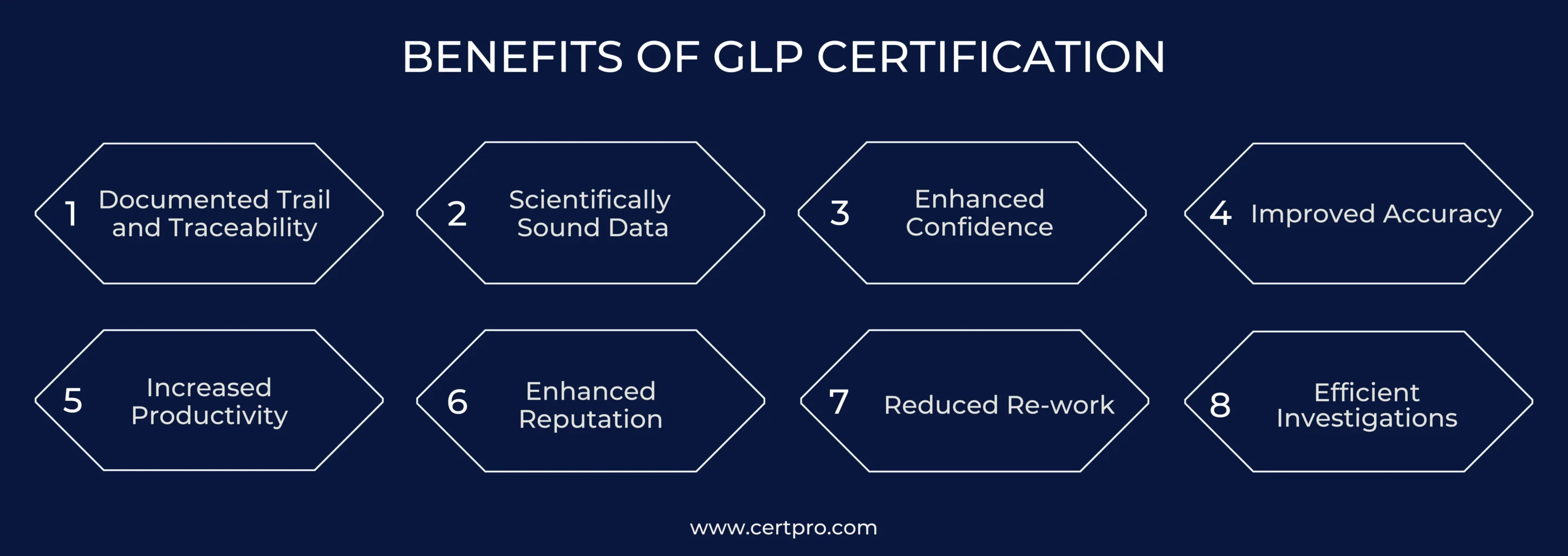GLP
GOOD LABORATORY PRACTICE
Good Laboratory Practice (GLP) includes principles that govern all stages of laboratory studies. These include planning, executing, monitoring, documenting, reporting, and archiving. GLP is essential for ensuring the credibility and traceability of data. This addresses issues of non-reproducibility in pharmaceutical analysis. Additionally, it reduces adverse drug effects and enhances human and environmental safety. Detailed documentation under GLP ensures accountability and precision. Responsibility is assigned at each experiment step.
The International Council for Harmonization (ICH) acknowledges GLP as essential for international pharmaceutical registration. Organizations gain from GLP accreditation in several ways. It improves regulatory compliance and data reliability, enhancing their standing and simplifying the authorization procedures. Time-to-market is shortened, and non-compliance-related risks are lessened. Moreover, GLP promotes cooperation and strengthens the legitimacy of science. Ensuring data integrity facilitates more informed decisions about environmental and public health.

CERTIFICATION AND AUDITING SERVICES BY CERTPRO FOR GLP
At CertPro, we recognize the importance of following Good Laboratory Practice (GLP) guidelines. Obtaining GLP certification benefits organizations by improving laboratory processes. We provide thorough support to organizations aiming for GLP certification. Our experts will assist you throughout the certification process. We ensure your laboratory practices meet current GLP standards. Working closely with your team, we develop a customized GLP compliance framework that addresses your industry needs and regulatory requirements.
WHY CHOOSE CERTPRO FOR GLP CERTIFICATION AND AUDITING?
CertPro is a dependable partner for GLP certification and auditing services. We have practical experience, so we know how complicated laboratory management may be. CertPro is the best choice for your GLP certification needs for the following reasons:
| Factors | CertPro Advantage |
|---|---|
| Time to Certification | 4x faster than traditional approaches |
| Price | Competitive rates with flexible options |
| Process | Streamlined and efficient methodology |
| Expertise | 10+ years of industry experience |
CERTPRO’S COST-EFFECTIVE APPROACH TO GLP CERTIFICATION
Regarding Good Laboratory Practice (GLP) certification, the overall cost is a crucial factor to consider. It includes a range of factors that affect costs. We at CertPro understand the value of cost-effectiveness. We aim to provide economical, specialized solutions that meet your company’s GLP criteria. This is a synopsis of our economic GLP certification process:
| No. of employees | Timeline | Cost (approx.) |
| 1 – 25 | 4 weeks | 2500 USD |
| 25-100 | 6 weeks | 3500 USD |
| 100-250 | 6-8 weeks | 5000 USD |
| 250 plus | 8 weeks | Custom plans |
UNDERSTANDING THE GOOD LABORATORY PRACTICE
Good Laboratory Practice (GLP) is a set of guidelines that ensure the quality of lab studies. These guidelines cover everything from planning the study to archiving the results. The main goal of GLP is to provide the trustworthiness of the data from these studies. This is especially important in fields like medicine and other areas with strict regulations. GLP isn’t a system for conducting scientific research but rather for ensuring studies are done correctly. It focuses on ensuring data is collected accurately and reported honestly. GLP also helps labs maintain high standards for data organization and documentation.
One of the biggest challenges GLP addresses is that experiments must be reproducible. By following guidelines from the OECD, labs can create clear and detailed documentation. This documentation helps hold everyone involved in the study accountable for their work. GLP also emphasizes following established protocols and assigning clear responsibilities for each step of the experiment. This improves the overall quality of the study and makes the data more reliable and accessible to track.
A separate Quality Assurance (QA) unit is integral to GLP. This unit acts independently, monitoring the entire study process from start to finish. This includes how the study is conducted, how the data is analyzed, and how the results are reported. The QA unit ensures the lab follows the correct procedures and obtains all necessary reviews and approvals. While QA audits help ensure procedures are followed correctly, they don’t guarantee the science itself is perfect or that there will be no errors in the analysis.
STEPS TO OBTAIN GLP CERTIFICATION
Novice organizations face a significant challenge in implementing the OECD Principles of Good Laboratory Practice (GLP). The objective is to establish a sequential framework for implementing GLP. While there are multiple approaches to achieving GLP compliance, these are the following steps for implementing GLP:
Organization: Conduct comprehensive GLP training for all staff members. Set up an organizational structure that includes management personnel, study directors, and quality assurance personnel. Management should choose people for these roles. They should also create a standard format. This format will handle personal information.
Responsibility: Ensure protocols and study plans are approved. Provide access to SOPs and conduct studies under GLP principles. Develop workflow SOPs for protocols, comply with SOP instructions, record raw data accurately, and interpret, analyze, document, and report results.
Facility: Ensure physical infrastructure, equipment, and environmental conditions meet GLP requirements. Implement maintenance, calibration, and validation procedures for laboratory equipment. Develop SOPs for facility management, equipment usage, and maintenance. Regularly inspect and audit the facility for GLP compliance.
Quality Assurance Unit: Create a Quality Assurance (QA) unit. Develop an Operational Assessment (OA) program with approved protocols. Use three inspection methods to find deviations. Report these deviations to the Study Director (SD) and management—train staff on verification and inspection techniques. Conduct regular training sessions for all staff members.
Apparatus, Materials, and Reagents: Establish clear guidelines for the identification, handling, and storage of apparatus, materials, and reagents. Specify reagent use as per SOPs. Develop rules and SOPs for tasks like solution preparation to ensure consistent practices.
Establishment: Establish rules for acquiring and approving raw data. Define auditing processes for raw data across all units. Develop SOPs for verification and quality control tasks.
Raw Data: Prepare validation protocols for systems needing validation. Identify and deploy validated systems formally. Draft approved validation reports and establish SOPs for organizing access rights.
Achieve Documentation: Review existing SOPs and list remaining SOPs. Develop a timeline for completing SOPs, including authorship and revision. Create a comprehensive calendar for ongoing studies. Conduct a second gap analysis to identify remaining non-compliance areas with GLP.
Implementing GLP involves meticulous planning, rigorous procedure adherence, and ongoing training and evaluation. These steps ensure organizations effectively achieve and maintain GLP compliance.

REQUIREMENTS FOR GLP CERTIFICATION
Good Laboratory Practice Certification has critical requirements. These are similar to ISO 17025. Additionally, it includes specific GLP requirements:
Test Facility Management (TFM): Test Facility Management (TFM) is essential for GLP certification. It manages the facility to follow GLP principles.
Study Director (SD): Appoint a Study Director (SD) to oversee each study’s conduct and ensure GLP compliance.
Archivist: Designate an archivist to organize and maintain test facility records.
Independent Quality Assurance Unit and QA Program: This unit audits test facility operations. Additionally, a QA program should be developed to support this.
GLP-compliant Study Conduct and Study Inspection: Firms must conduct studies following GLP guidelines and ensure regular inspections for compliance.
GLP-compliant Study Documentation: Always create GLP-compliant study documentation. Write thorough reports, statements, and protocols.
GLP Archive: Maintain a GLP archive to ensure traceability and integrity. Test data can also be stored securely for at least 15 years.
GLP Training: Provide GLP staff training. Teach them requirements, procedures, and concepts.
GLP strongly emphasizes the traceability and safety of the original test data. It assigns each research participant to an activity.
BENEFITS OF GLP CERTIFICATION
Adhering to good laboratory practice certification offers significant benefits. Firstly, it enhances data traceability, quality, and credibility. Moreover, it brings numerous advantages for both the laboratory and its customers. Here are the key points highlighting the benefits of GLP:
- Documented Trail and Traceability: A documented trail ensures traceability for all measurements. Additionally, it enables easy tracking and verification of data. Thus enhancing transparency and accountability.
- Scientifically Sound Data: GLP ensures high-quality data and enhances reliability and credibility. Following GLP principles reduces errors and minimizes gaps in results.
- Enhanced Confidence: GLP increases confidence in the reliability and integrity of laboratory data. Stakeholders, including clients and regulatory bodies, have increased confidence in the data produced.
- Improved Accuracy: Adhering to GLP principles increases the production of right-first-time results. It also minimizes errors and reduces the need for repeated experiments, ensuring data accuracy and validity.
- Increased Productivity: GLP practices contribute to enhanced overall productivity within the laboratory. Additionally, streamlining processes, minimizing errors, and optimizing resource utilization lead to improved efficiency.
- Enhanced Reputation: Following GLP standards enhances the laboratory’s reputation. This certification is essential in delivering high-quality and reliable data and builds trust among clients, regulatory authorities, and stakeholders.
- Reduced Re-work: Adherence to GLP minimizes the need for rework and repeated experiments. It saves valuable time, effort, and resources by reducing errors. Moreover, it ensures data integrity.
- Efficient Investigations: GLP implementation reduces the time spent on non-revenue-earning investigations. Furthermore, it allows the laboratory to focus more on productive activities and scientific advancements.
Adhering to GLP principles creates a strong data trail that ensures data is correct and can be tracked. To begin with, data trust grows, and accuracy improves. Efficiency also increases, leading to a better image. If this were done, there would be no need to redo anything, which would speed up probes.
Adhering to GLP ensures reliable results that meet regulatory requirements and customer expectations. Thus, GLP principles are crucial for success.

ELIGIBILITY FOR GLP CERTIFICATION
Businesses, test centers, and labs can choose to avoid getting GLP approval. It is essential for food additives, medicines, and colorants. It is also necessary for regulated businesses like food packaging, medical products, etc. Before a business can sell its goods, it needs to get permission from the government. Companies that get good laboratory practice licensing promise to keep lab standards high. It helps them follow the rules and make sure their info is correct. GLP licensing boosts trustworthiness, makes data more accurate, and makes it easier for products to be approved.
GLP approval is suitable for both businesses and the government that oversees them. It helps ensure strict rules are followed when creating, testing, and registering products. Hence, certification for good laboratory practice is necessary to ensure businesses follow strict regulations and strive for success in their work.
GLP CERTIFICATION COST
Many things affect how much GLP approval costs. To begin, things like reports cost money. Second, keeping records and managing data also cost more. Tools are also needed to create and follow processes. It costs more to train staff on GLP concepts. Setting up means for compliance also costs a lot of money. Ongoing costs are affected by annual costs like reports and yearly monitoring. Costs are also affected by how many sponsors there are. Costs per sponsor tend to go down as the number of sponsors rises.
On the other hand, having fewer donors might increase each person’s costs. The fees of GLP approval are necessary to meet standards. They keep the goods safe and follow the rules. Thus, these costs are essential to keep standards high. Organizations should think about long-term rewards. For example, having a better image and more trust are significant benefits. Another important advantage is that it makes the business more competitive. Hence, companies can make intelligent choices when they look at cost-effectiveness.
DURATION OF GLP CERTIFICATION: HOW LONG DOES IT LAST
The GLP (Good Laboratory Practice) certificate is valid for three years from the date it was given. During this time, regulatory groups check annually to ensure that GLP guidelines are followed. Because of this, checks, evaluations, and reports are done. Every three years, there is a full review, which renews the license. The process ensures that GLP standards are followed and proper paperwork, quality control, and lab practices are used. So, the three-year validity makes sure that obedience and good performance continue.
Additionally, this certification shows an organization’s commitment. It highlights responsibility, quality, and integrity in lab operations. Maintaining good laboratory practice certification ensures reliable and accurate data, which builds trust with stakeholders and shows that the organization meets high standards. Regular checks and reassessments help maintain confidence. It provides the lab’s practices, and the results are consistent. Furthermore, this compliance meets both industry expectations and regulatory requirements.
CERTPRO: YOUR GUIDE TO ACHIEVING GLP CERTIFICATION
Good Laboratory Practice (GLP) approval is something that CertPro helps businesses get. We do things like accounting, advising, and getting things certified. Our skilled professionals and advisors walk through each step of the certification process. In addition, we make sure your company follows GLP rules and market standards. CertPro looks at how you run your lab, finds things that could be better, and helps you set up quality control processes. We also help you meet GLP standards by giving you paperwork and expert advice. Working with CertPro shows you care about running a reliable and accurate lab. Thus, you can get GLP approval to help your customers and other essential people trust you and ensure your lab meets all government and industry standards. Overall, CertPro’s services make your lab look better and work better. By working with us, you can be sure your lab will follow high and honest standards.
FAQ’s
IS GLP CERTIFICATION MANDATORY?
GLP certification is not mandatory in all cases, but it is often required or highly recommended for organizations involved in nonclinical research and development, product testing, and regulatory submissions.
CAN A SMALL ORGANIZATION OBTAIN GLP CERTIFICATION?
Yes, GLP certification is available for organizations of all sizes. The requirements and processes may vary based on the organization’s scope and complexity, but small organizations can also achieve GLP certification by implementing the necessary systems and practices.
SHOULD testing FACILITY MANAGEMENT BE AN INDIVIDUAL OR A TEAM?
Under GLP principles, it is allowed to have either an individual or a team responsible for test facility management. In the case of a team, it is necessary to clearly define the management responsibilities assigned to each individual based on their roles within the facility. This documentation ensures clarity, defines communication lines, avoids conflicts of interest, and ensures compliance with the requirements of the GLP Principles.
IS IT PERMISSIBLE FOR THE HEAD OF TEST FACILITY MANAGEMENT TO ASSUME RESPONSIBILITY FOR QUALITY ASSURANCE?
No, assigning the responsibility of quality assurance to the head of test facility management would create a conflict of interest, resulting in non-compliance. In such cases, it is recommended to engage an external quality assurance function, especially for small test facilities.
ARE GLP INSPECTORS AUTHORIZED TO COMMENT ON STUDY-RELATED SCIENTIFIC ISSUES?
GLP inspectors may comment on study-related scientific issues depending on the specific circumstances. Deviations from the study plan methodology or issues impacting data validity fall under GLP concerns. When appropriate, the receiving authority’s assessor evaluates study design issues and advises informing them.
NAVIGATING DATA PRIVACY FRAMEWORKS: A COMPREHENSIVE GUIDE
Globalization has intense effects on business functioning and scaling. In today's digital world, companies are generating an unprecedented rate of data that requires protection from emerging cyber threats. In addition, recurring data breaches and privacy concerns make...
BUSINESS NON-COMPLIANCE: THE HIDDEN FINANCIAL AND OPERATIONAL COSTS
Businesses are always in a dilemma regarding whether or not to be compliant. Most companies think that compliance will problematize their operating process. However, highly regulated industries like financial and healthcare services meet the legal obligations for...
Security Frameworks: A Comprehensive Guide with 14 Examples
Technological advancements make cyberattacks more sophisticated and advanced. Hence, organizations must keep up with the latest cybersecurity frameworks in these complicated scenarios to sustain themselves in a dynamic threat environment. Different cybersecurity...



